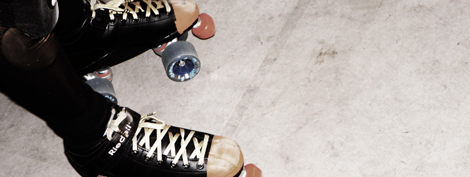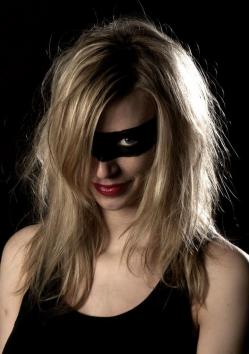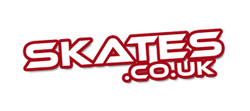Transitions – 4 common issues to the mohawk and how to fix it
6January 20, 2014 by alinedecat
For the apprentice skater, there are some skills that are often considered as passing a level when mastered.
The standard transition, also known as the mohawk, is probably one of them. Not only does it require balance and agility, but also coordination, and the ability to step out of balance and get back to a steady position as fast as possible.

picture by Gate Festa aka Mr Destroy
Ok first of all, what is a mohawk and how perform it?
The mohawk is a transition in skating direction, from forwards to backwards, or from backwards to forwards, using only inside edges if starting forwards and only outside edges if starting backwards (so not switching edge), and including a feet swtich. The 3-step, for instance, includes switching edges, but not switching feet.
So from forward to backward, and to the right, here is how it goes:
- Put weight on left foot
- Open upper body all the way to the right (180°), starting with the head, then shoulders, then waist
- Lift right foot and open leg from the hip all the way to the right (180°) and put all weight on it
- Lift left foot and put it back next to right foot
So, basically, it’s open and close. Imagine your legs are a book cover. This is how open your legs must be. Yes, I said legs, not feet. I also brought your attention on the fact that the turn starts with head, then shoulders, then waist, and then finally legs. Let’s put a pin in this.

Now, there are some issues that apprentice skaters repeatedly encounter when learning the mohawk. Although this may also be interesting for advanced skaters since they sometimes end up mastering the mohawk with high speed and full balance in one direction, but having an unexplainable issue with the other direction.
1. My arms swing around after I turned round
You probably start the move with your hips and not the upper body. Keep in mind that your head leads the twisting, and then the shoulders, so the more you turn them, the more your whole upper body will turn, dragging your hips and thus your legs too.
The faster your torso reaches its final position, the faster the balance can be recovered too. If you can’t handle your whole body at the same time, why not move progressively, starting with the top?
Solution:
Start on a straight line, with your hands held together.
Your hands need to point at a mark far away in front of you (on the wall, for instance). Make sure you stretch your arms to aim for the designated mark as much as you can.
On the whistle, you will have to bring your arms in, then aim for the same mirrored mark on the opposite wall, before you can even lift up your feet. Also with arms stretched towards it.
Make sure your arms are making a 180° turn.
This exercise can also be done with a ball in hands. The heavier the ball is, the more effective the drill will be.
Why is this helping?
Asking the skater to aim with fists together is actually asking them to turn their shoulders more, but the focus on the hands give them the awareness of what they are doing exactly. They can see their hands, unlike their shoulders, they can see if they’re actually turning 180°, and if not, correct it on the spot. But the shoulders are still doing the job.
Also, the aiming will force them to start with turning their head, as they need to spot the mark in the first place.
2. I need more than 2 steps to turn completely, or I need to jump
This probably means you’re not “opening your book” enough, in other terms, your first step doesn’t put your foot 180° away from the other one.
This usually happens when the skater tries to open the foot only, and not the whole leg from the hip. So the foot is not open enough, it’s not rolling, and it can’t carry the whole weight for the one last step.
Solution:
Practice sideways skating, on- and offskate.
Once again, to be aware of your shoulders, strech your arms out above your feet and make them move exactly like your feet:
Position 1: both arms parallel in front of skater skating forwards
Position 2: arms open and as straight as can be while skating sideways
Position 3: both arms parallel in front of skater skating backwards
Oh, and when I say stretched, it’s really like you are trying to make them grow. It’s either derby position or really (I mean REALLY) stretched out, anything in between is not helping at all and actually unbalancing you.
Yeah, figure skaters are position despots. Deal with it. 😉
Also, like for section 1, putting weight in hands will increase the effects of the drill. You don’t need a lot of material, bottles of water are already fine.
Why is this helping?
Since the issue is that your book isn’t open enough, this is going straight to the problem. To be able to go from regular position to sideways means you can put your whole body sideways, which is the middle position of the transition, unless you don’t get out of that position right away, you take the time to put your weight on both feet, and then on the rear foot.
3. I keep on tripping before even turning round
You do probably not notice, but you are taking an extra step with the opposite foot before opening the book. Some people do it because they aren’t confident enough to take one 180° step to the back, others are just confused what foot to start with in which direction.
Solution:
Start with lifting the foot that is supposed to take the first step (right one on the image) and count to 3. Do not put it back on the floor but initiate the move right after that.
If needed, you can use arms as in section 2. In this case, it is more about being conscious of what feet do, since arms are supposed to mirror them.
Why is this helping?
You can’t take an extra step if the other foot is already lifted up. Sounds obvious, still valid.
4. I can’t preserve my speed or my trajectory
You’re not actually stepping, you are actually making a bow.
It is usually the second step that is skipped, and the result of that is that you find yourself on a double inside edge, with open feet, and your momentum is broken by that.
The result of it is either turning or slowing down, or even both.
Solution:
Just focus on the sound. Stomp your feet while turning, and expect both feet to make exactly the same noise.
How is this helping?
Same sound means same movement, thus also same height. Although advanced skaters may just lift the front wheels and pivot on the rear wheels, it is better to learn it with complete stepping first, and then get back to letting the rear wheels on the floor.
Always take good habits with exagerated moves first.
So, I hope this helped, feel free to comment and ask if you have any questions 😉



This breakdown and troubleshooting helps tremendously! It’s easy enough to show New Skaters the skill but much harder to explain exactly what they should be doing and when. I’ve also wondered which end of the skate, front or back, is better to lift and which end to pivot when doing this transition as an advanced skater. I’ve found that bending my knees and getting lower before attempting this transition at higher speeds makes it easier and less scary. Maybe it’s because I’m able to open my legs/hips more, or that I’m lowering my center of gravity.
Thank you! So glad it helps! xxx
[…] As we saw previously, you can’t open your foot only, you need to open it from the groin to the tiptoe. Twisting your knee or your ankle is definitely not a good idea anyway. That’s not what it was made for. […]
Hi 🙂
Do you have any suggestions for stretches for hip flexors that may help with transitions? I am finding that my problem lies in the fact that I don’t have a wide turnout. Or perhaps any suggestions as to how I can get around this problem? Thanks in advance!
I keep feeling like I’m tripping on my backwards to forwards transitions; like my back foot is almost getting backwards momentum. Any suggestions?
Hi Molly! Can you maybe send me a short video?
xxx